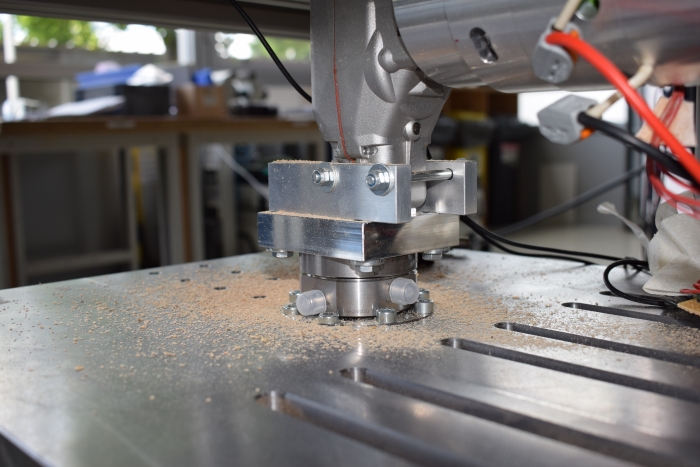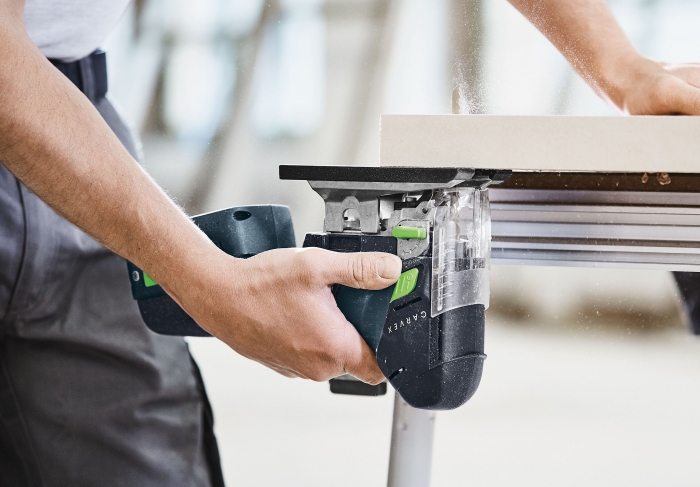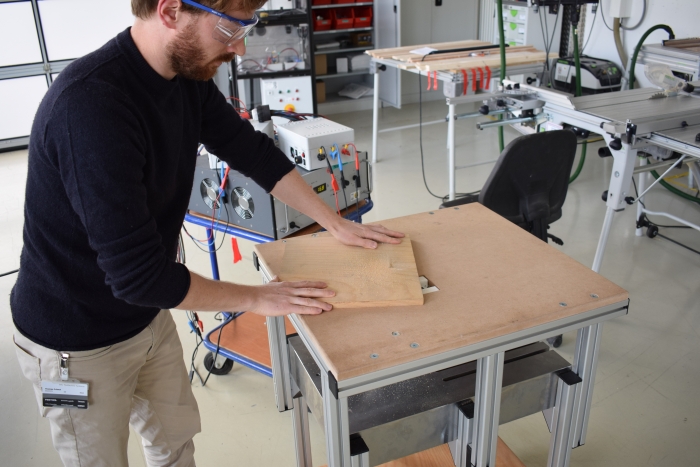Article and images from the Kistler Group
Leading power tool manufacturer Festool opts for a six-component force/moment sensor from Kistler to develop its new jigsaws. The compact piezoelectric quartz load cell captures forces and moments during the sawing process: a key advantage for testing new jigsaws and validating saw blades.
Festool, a manufacturer of system solutions, can look back on a lengthy tradition of developing high-quality power tools for timber construction, carpentry, painting and renovation work. Technical innovation began as soon as the company was founded back in 1925, with the introduction of the first transportable chainsaw. Alongside saws of different designs to serve various purposes, Festool's portfolio now includes other high-caliber power tools for professional users such as sanders, routers and extractors, together with a full range of drilling and screwdriving products. The company has over 475 patents to its name and its innovations have been honored with numerous awards.

Precise measurements of dynamic forces and moments acting on jigsaws – with the six-component force/moment sensor from Kistler. The saw is mounted upside-down.
A long tradition of working closely with professional tradespeople
Drawing on the industry and technology expertise it has accumulated over many years, Festool develops power tools that set standards in terms of precision, durability, ergonomics and design. Product characteristics must be precisely tailored to real requirements: to achieve this, Festool's teams collaborate closely with professional tradespeople. Every product undergoes extensive quality and load tests before its market launch. Products only reach the market once Festool can clearly prove that they are robust, reliable and durable.
Optimal solution: jigsaws for smooth, clean and fast cutting
"Jigsaws are among the tools that carpenters use most often for fitting and assembly work," according to Thomas Fritsch, a designer in Festool's jig construction department. "The jigsaw is appreciated as a workhorse – an all-rounder that's equally suitable for use on wood, metals and even steel. There used to be frequent problems because cuts were inaccurate, with cracked or jagged edges. But there's been vast progress on those issues in recent years, and nowadays there's almost never any need for reworking."
Jigsaws have a major advantage over other types of saw: they are highly maneuverable. This makes them ideal for curved cuts, as well as cutouts. The depth of the cut generally corresponds to the full thickness of the material – and this is why there are so many different saw blade lengths. Modern jigsaws make use of what is known as a "pendulum stroke sawing strategy". Fritsch explains: "The back of the saw blade is guided by a roller. During the stroke movement, the pendulum action exerts rhythmic pressure on the saw blade. The result is that the blade not only moves up and down, but also forwards and backwards. This extra pendulum movement makes sawing more effective – and progress is up to three times faster."

Professionals prefer to saw from below: that gives them optimal visibility of the saw blade and the scribe line.
Trend: smaller, lighter, better ergonomics and more mobility
The saw blade, the pendulum stroke and the automatic speed control of a Festool jigsaw can be set precisely to match the workpiece material – so every cut is a perfect success, even when tight curves or extreme angles are involved. Fritsch continues: "Professionals prefer to saw from below, because that gives them optimal visibility of the saw blade and the scribe line. And to cope with confined spaces, the tool should be as small and lightweight as possible, with a powerful accumulator battery for maximum staying power and mobility."
Ongoing development thanks to support from a strong technology partner
Festool's research and development facility is located at the company's headquarters in Wendlingen near Stuttgart, Germany. This is where Festool develops and tests the latest generation of its pendulum jigsaws. A test rig for new saws has been set up in the company's jig construction department. The six-component force/moment sensor from Kistler (9306A31) is deployed here to measure the forces and all the moments acting on the saw blade – along all three spatial axes. Fritsch is delighted with the results: "Kistler is in a class of its own in the world of measurement technology. Back in my student days, I was already working with piezoelectric sensors from Kistler. Thanks to the know-how and advice provided by the Kistler service team, it only took us two months to set up our test rig."
Festool tests and validates its own jigsaws and saw blades, as well as competitors' products. This involves mounting each jigsaw upside-down on the sensor, which is fastened onto a heavy steel plate to ensure that it remains fixed on one side. Thanks to its compact design, it is easy to install the piezoelectric six-component force/moment sensor in the test rig, where it measures the three dynamic forces that are perpendicular to each other in the directions of compression and tension, as well as the torsional and bending moments.
Data acquisition is handled by the LabAmp 5167A multiple-channel charge amplifier from Kistler. Integrated data acquisition and fully digital signal conditioning are features that simplify the measuring chain, enabling direct integration into customers' own system environments.

The test rig serves Festool to evaluate the performance capability of new jigsaws and saw blades.
A convincing combination: know-how and service
Thanks to this test rig, Festool's developers can test the jigsaws themselves and expand their own expertise in this field as well. The measurement data provides valuable insights into the sawing process – the basis not only for evaluating existing jigsaws and saw blades but also for developing new versions. "Kistler's measurement technicians immediately grasped what we wanted, and what we needed to achieve it. The test works thanks to their experience, professionalism and efficient support," Fritsch emphasizes. "Of course, salespeople often promise the impossible. But then you're in for a disappointment when you talk to the technical staff. That wasn't at all the case with Kistler. Their sales staff worked with us as we developed this solution together. And we're very pleased with it."
Objective measurement data – the basis for competitive edge
He goes on to explain: "The purpose of the measurements is to generate reference values that we can use as the basis for comparing our saws with competitors' products. Our customers often use a Festool saw, but they fit cheap saw blades onto it. And then when it doesn't work, they complain to us." One of the key factors here is providing colleagues in the sales force with reliable information so they can give recommendations when advising customers. Objective data should be used to ensure that customers are offered the best possible combinations of Festool saws and saw blades, in line with their requirements, so they can achieve optimum results. This makes it easier to persuade customers that it pays to invest in premium saw blades from Festool.”
Related Glossary Terms
- jig
jig
Tooling usually considered to be a stationary apparatus. A jig assists in the assembly or manufacture of a part or device. It holds the workpiece while guiding the cutting tool with a bushing. A jig used in subassembly or final assembly might provide assembly aids such as alignments and adjustments. See fixture.
- sawing
sawing
Machining operation in which a powered machine, usually equipped with a blade having milled or ground teeth, is used to part material (cutoff) or give it a new shape (contour bandsawing, band machining). Four basic types of sawing operations are: hacksawing (power or manual operation in which the blade moves back and forth through the work, cutting on one of the strokes); cold or circular sawing (a rotating, circular, toothed blade parts the material much as a workshop table saw or radial-arm saw cuts wood); bandsawing (a flexible, toothed blade rides on wheels under tension and is guided through the work); and abrasive sawing (abrasive points attached to a fiber or metal backing part stock, could be considered a grinding operation).
- sawing machine ( saw)
sawing machine ( saw)
Machine designed to use a serrated-tooth blade to cut metal or other material. Comes in a wide variety of styles but takes one of four basic forms: hacksaw (a simple, rugged machine that uses a reciprocating motion to part metal or other material); cold or circular saw (powers a circular blade that cuts structural materials); bandsaw (runs an endless band; the two basic types are cutoff and contour band machines, which cut intricate contours and shapes); and abrasive cutoff saw (similar in appearance to the cold saw, but uses an abrasive disc that rotates at high speeds rather than a blade with serrated teeth).
